Photo Corners headlinesarchivemikepasini.com
![]()
A S C R A P B O O K O F S O L U T I O N S F O R T H E P H O T O G R A P H E R
![]()
Reviews of photography products that enhance the enjoyment of taking pictures. Published frequently but irregularly.
On Assignment: Wedding Video Prep


2 July 2013
Before we start cooking the raw video into a multi-layered, special effects emotional lasagne, we're taking a moment to reflect on the shoot itself. What we did, what worked, what didn't. Unlike your usual Wedding Video Tips article, this one will have some tasty appetizers and belly-expanding advice.
But it won't be a How To article.
Because the best advice we can give any amateur who is asked to take video at the wedding of a relative is to decline.
Do it politely and if you're able to, offer to pay for a professional videographer to solve the problem. Or concoct some viral video vortex where everyone is encouraged to whip out their smart phones, shoot video and upload to the same sharing site where magical algorithms assemble the random footage (at least chronologically).
WHY NOT? | Back to Contents
You may have already noticed that we didn't follow our own advice. Point conceded. We plead mitigating circumstances. ("That cad wouldn't cut our video!")
But we really do feel obliged to dampen any enthusiasm out there. Even for us it wasn't what you'd call a good idea.
Because you are going to be disappointed. And you may even be in the way of several professionals trying to do their job. Like the still photographers, the DJ, the master of ceremonies, the food service staff. They have hard jobs and being nice to a clown fumbling with a camcorder and constantly stepping in their way is asking too much.
But you also won't be present at the event. It's a job, after all. And a big part of it is to know what's supposed to happen when and to anticipate what could happen. In a few seconds or two hours from now. You're always thinking ahead. Because you have to be there before it happens.
So no drinking and eat only when there's nothing else to do. Tough, no? Yes. Prepare your date to feel neglected.
And not just at the reception. You're making a several month commitment to editing the video into a movie after it's all over, too.
THE GEAR ISSUE | Back to Contents
In addition to all that, we had the additional problem of using someone else's gear. Our camcorders are from another century, their batteries fossilized, their tapes disintegrating. We've moved on, shooting video with a digicam or m4/3 camera.
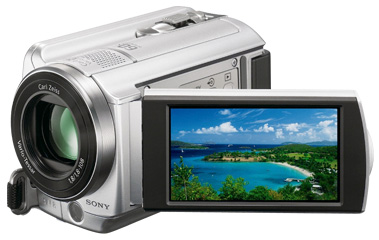
The Camcorder. Compact with plenty of storage.
We were also flying across the country the day before the wedding, so we couldn't reasonable expect to arrive with our luggage and a Pelican case of gear. So it was beg and borrow time.
We'll link to the actual equipment we used, but most of it is no longer available.
The bride's sister, who was also her matron of honor, had a Sony DCR-SR88 camcorder. It records on either SD cards or an internal hard disk. The battery (we can attest) lasts longer than some marriages. We procured a copy of the PDF manual and went over it, making sure to request the charger and some room on the hard disk. OUr SD cards are too slow and small for video.
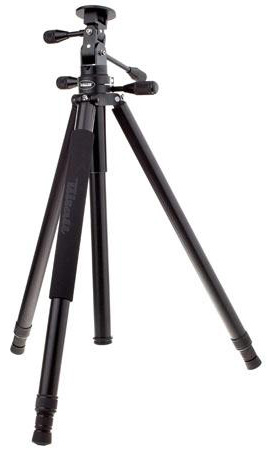
The Tripod. Tall and strong.
The groom's father provided a tripod, an old Star-D Professional whose modern equivalent would be a Tiltall TE01B. That's a story in itself. But it brings up another admonition. As an amateur, you might not even think of using a tripod, happy with that edgy handheld look, say. Or not wanting to be conspicuous. But it was worth it's weight in wedding cake for reasons -- yes, more than one -- even we didn't realize at first.
Still, you might not appreciate how important the tripod head is. There's quite a difference between what you do with a camcorder on a tripod and what you do with a still camera. There are heads that make that feasible and heads that make that very difficult. As we got on the plane, we had no idea which we would have.
Even though the video gear was being provided, Plan B was our responsibility. We packed a m4/3 camera we were pretty familiar with. It takes nice HD video but manual zooming is always jumpy.
And then there's the real video killer. Audio.
Good audio separates professional video from amateur video. It's difficult to capture and the pro gear you need to do it isn't cheap.
The wedding would be held in an outdoor venue, on the dock by a windy bay. We would be shooting from the periphery to avoid disrupting the ceremony and getting in the stills. What chance would we have of capturing the bride timidly reciting her vow?
None, brother. None whatsoever.
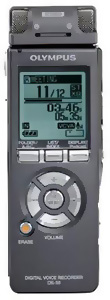
Digital Voice Recorder. Our secret weapon.
So we packed along a small but remarkable Olympus DS-30 digital recorder that could slip into the jacket pocket of the groom. Ideally, there would be amplified sound that would capture not just the officiant (shall we call him) but the wedding couple, too. So this was our Plan B for audio.
Plan C was a voiceover. With audio, you need a Plan C.
Plan B really wasn't ideal, we knew. A wireless lavaliere mic hidden on the groom's lapel would have been better. As any pro would tell you.
MEDIA | Back to Contents
Not everything is a disaster. In this case, we knew we'd have an HD-video-fast 32-GB SD card for the Sony camcorder. We were less happy with our SD media for the Olympus E-PL1 m4/3 digicam.
We had an assortment of SD cards about 2-GB in size and one problematic 8-GB Eye-Fi card that just didn't seem to like the E-PL1, though it worked reliably in other cameras. It would record a few shots or videos and then suddenly complain about a card error and report the card was write protected after that.
We formatted the Eye-Fi card in the camera and did some test videos only to repeat the problem. Eye-Fi claims the card is compatible with the camera, but that's never been our experience.
But we did manage to salvage some test videos we took on the card using Disk Utility. Photo Rescue wasn't able to find anything (but the card only had video on it). Disk Utility complained it couldn't unmount it. But after a firmware update, Disk Utility ran normally and repaired the SD card.
If you think we were going to trust it, though, you're crazier than we were to accept the assignment.
Instead we borrowed an idle 8-GB card (fast enough for HD video) and put that in the E-PL1. That was enough room to shoot a few stills and capture some secondary video, we thought.
Boy, would we be surprised.
MEDIA RECONSIDERED | Back to Contents
Being light on your feet is a real advantage in these situations. We had a 32-GB card to record video with the Sony but it also had an empty hard disk. Why wouldn't we give ourselves some breathing room with that?
Actually both were more than generous for what we ended up shooting.
But we decided to write to the hard disk instead of the SD card and later copy to the SD card to transfer video to our external hard drive and a 16-GB thumbdrive. Two copies on different media from the original source.
This scheme had a pleasant if unforeseen advantage.
When we were done with the equipment, we were able to 1) return the camcorder to the matron of honor with the video on its hard disk and 2) return the two SD cards to their single owner with everything on it. A prehistoric form a sharing, maybe, but it was very much appreciated by both parties.
Images from our video starting showing up on Facebook pages right after the wedding.
THE REQUEST | Back to Contents
The groom had himself asked us to shoot the wedding (which was the mitigating circumstance we referred to). And in his request he outlined the events he wanted captured: the ceremony itself, the speeches and the first dances.
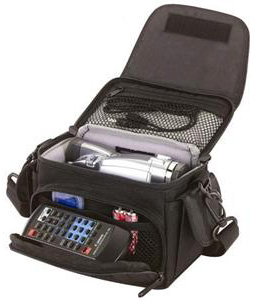
Compact Bag. Handier than we expected.
That was very helpful.
But in our reply we mentioned that it would also be very helpful to attend the rehearsal and meet with the still photographer. It turned out the still photographer did not attend the rehearsal but we did. More on that later.
On our way to the rehearsal, we picked up the tripod and the camcorder in a compact Lowepro Edit 110 bag that turned out to be perfect.
We also sat down with the groom for 15 minutes before the rehearsal and casually chatted about what he wanted (just in case the list had grown longer since the request) so we wouldn't miss anything important to him and his bride. And it boiled down to about what he had requested originally.
THE REHEARSAL | Back to Contents
Fortunately the rehearsal was scheduled for late afternoon, which was the same time of day as the event itself. That gave us a chance to check the weather conditions and position of the sun.
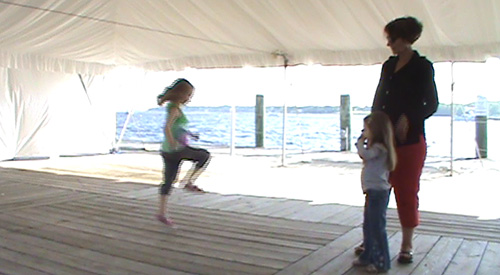
The Venue. Open to the (very bright) bay in the back.
The venue was a tent on a deck-like dock right on the water. Wind blew pretty strongly from left to right over the water behind the tent. And the sun was low and beaming into the tent from the water, too. So we had a classic backlit scenario mitigated a bit by the white tent.
Oh boy.
There were other little problems over which we'd have no control. The ceremony, for example, would be conducted right in front of an red illuminated Exit sign. That seemed over the top for an open-air tent but the tent had fabric walls that could be dropped down so it wasn't as silly as it seemed. We were told it would be covered but it would still have to be visible.
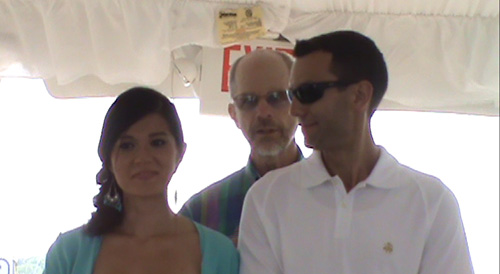
Exit Sign. You can't control everything.
This would be our first chance to shoot with the camcorder, so we used it handheld during the rehearsal from a number of angles as the participants took their places. It also gave us a chance to capture some audio on both the camcorder and the digital recorder to evaluate how well each would do.
We took about a dozen clips during the rehearsal. Later that night, we copied them to our external disks and reviewed them, making a few notes on what to do and what not to do. That was invaluable.
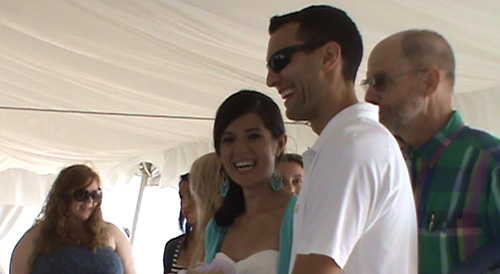
Angles. One angle we didn't use.
Our test of the audio was also invaluable. We weren't going to pick up audio across the room with either device but digital recorder did a nice job capturing conversations in a small group. So we were confident it would pick up the vows if the amplified audio didn't broadcast them.
POSITIONS | Back to Contents
Another insight we gained from the rehearsal was some idea of where to position the tripod.
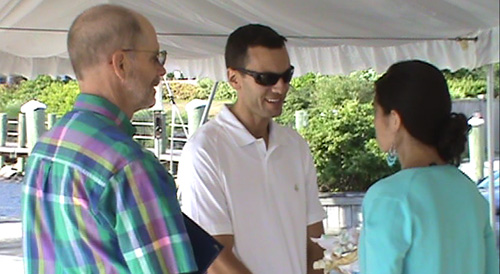
Best Light. But, as it turns out, not a good location.
We sketched a floor plan and marked three spots:
- One to the left side to capture the bridesmaids as they took their positions
- Another to the right as an alternate if something prevented us from being on the left, and
- One in the back, slightly off center to stay out of the aisle for the main service during which the couple would face each other (as we learned at the rehearsal).
We had to be off center because you don't want to block an exit.
Those three spots would most likely keep the tripod out of the still photos, too. We had no control over that, really, but we certainly could make ourselves as inconspicuous as possible.
Then we made a note of the main events our groom asked us to capture. Somehow writing all this down was a bit of a dress rehearsal for ourselves.
We hit the sack as the batteries for our cameras were charging.
(Editor's Note: This is the first of a four-part series on shooting a wedding video. Links to the other stories are in the main table of contents at the top right of each story.)